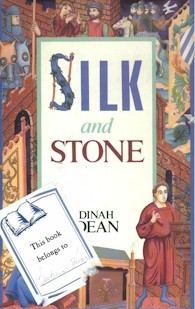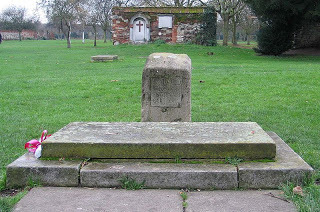Reviews of obscure books: Silk and Stone, by Dinah Dean
 It's been well over a year since my last entry in the Reviews of Obscure Books series, so I figured it was about time for a new one. This is my copy of Dinah Dean's Silk and Stone, and when you find a book as obscure as this one is, you don't care that one of its past owners slapped an ugly bookplate on the front cover rather than on the flyleaf. Well, actually that's not true, but I'll deal with it.
It's been well over a year since my last entry in the Reviews of Obscure Books series, so I figured it was about time for a new one. This is my copy of Dinah Dean's Silk and Stone, and when you find a book as obscure as this one is, you don't care that one of its past owners slapped an ugly bookplate on the front cover rather than on the flyleaf. Well, actually that's not true, but I'll deal with it.Among others, Dean has written six mostly unconnected novels that take place in Waltham Abbey in Essex between the 11th and 19th centuries. Silk and Stone, the 2nd in this unofficial series, is set during the civil wars between King Stephen and Empress Matilda in the 1140s. But while the main characters all end up in the East of England, the novel begins on a pilgrimage far to the east and south.
Norman lady Mabilia de Wix, her 17-year-old daughter Elys, and their maid are in Rome, having traveled there in the company of Mabilia's haughty brother, Templar knight Sir Richard de Hastings. Elys's older brother Matthew has a wound in his foot that refuses to heal, and the women have made pilgrimages to holy places all over England and France in the hopes of curing him. All have failed, and they don't understand why. Novelist Diana Norman would have made a slyly irreverent remark about this over-the-top situation, and indeed I expected one, but here, the novel's gentle humor mingles with sadness. Unless Matthew lives, the family's noble line will die out.
If that's not bad enough, Elys hates the thought of going into a convent. Mabilia has plans to retire to the cloister, seeing it as the safest place during these traumatic times of constant war, and wants to see Elys settled there too. Elys's dowry has already been given to the nuns, so she has no hope for a decent marriage. Elys has other plans, though. An accomplished needlewoman, she thinks she has what it takes to be a professional broiderer.

The legendary tomb of King Harold II, which resides in Waltham
and is mentioned in the novel
Aylwin of Winchester, a master mason from a noble Saxon bloodline, sympathizes with Elys's predicament, and they become friends as he, his friend Sir Fulk, and her family wander back to England together. Her quest for independence gains ground in the town of Waltham Abbey; she impresses Father Warmand with her skill, and he hires her to design and sew an elaborate cope, or church vestment.
With her unorthodox choice of career, her refusal to become a nun, her mother's and uncle's disapproval, and Sir Fulk's unwillingness to marry her despite his obvious admiration, Elys has her hands full. Aylwin has feelings for her, but Elys is still blind to his attentions. Matthew's days are numbered, too; only a miracle can cure him. Fortunately, one may be at hand.
This isn't a good book on which to test the 50-page rule. Today's commercial fiction is obliged to grip the reader's attention immediately, but the initial few chapters of this one are slow. Imagine the pacing of a pilgrimage in the Middle Ages, and you'll get an idea of how slow. Things pick up as the plot begins to cohere, happily, and as Elys emerges as the novel's central figure.
Her plight is easy to understand — who would want to be forced into a nunnery? — but she belongs to her time rather than ours. Her romance with Aylwin develops realistically, with the shadow of the Norman Conquest, some seventy years earlier, still lingering in the background. She also doesn't realize how fortunate she is, not until later. Through the depiction of Elys's older sister Judith, who is now called Sister Helen, readers get to see the bitter result of a woman's regret-filled life.

The nave of Waltham Abbey
Dean presents a wonderfully detailed tapestry of the English medieval world, presenting the day-to-day occupations and concerns of nobility, craftspeople, and churchmen, although the weave isn't always as fine as it could be. In some scenes, she spoon-feeds information on England's political history; in others, she drops readers into a pile of medieval terminology and lets them sort out what's what. I liked the latter approach. The word "mystery" is used in the sense of "miracle," and to her credit, Dean explores her characters' religious mindsets without making them seem holier-than-thou. Instead, their faith feels like a natural part of their existence, which it was.
In her author's note, placed at the very beginning, Dean writes that many of her characters once lived, and that much of her plot is historically based rather than fictional. Lady Mabilia, Sir Richard, Matthew, and several of the townspeople are among the real ones, all mentioned in a chronicle written forty years later.
Dinah Dean's Silk and Stone was published by Barrie & Jenkins, London, in hardcover in 1990 (382pp). The RomanceWiki page has a complete bibliography of her work. Should you be interested in a copy of this one, there are a couple of reasonably-priced ones on Amazon UK. For now.
Published on August 12, 2011 20:26
No comments have been added yet.



